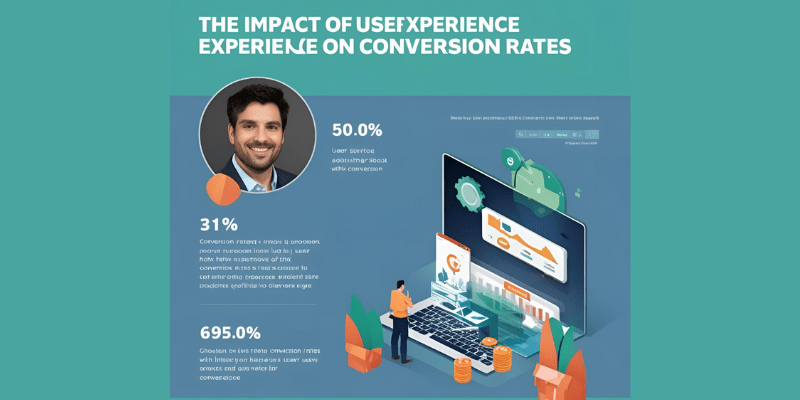The Impact of User Experience on Conversion Rates
Published: 23/Mar/2025
User experience (UX) plays a vital role in shaping the success of any online business. A seamless, engaging, and user-friendly experience on a website or app can significantly boost the user experience on conversion. Businesses focusing on UX see improved customer retention, higher sales, and increased customer satisfaction. But how exactly does UX affect conversion rates? In this detailed guide, we will explore the impact of UX on conversion rates, discuss best practices, and provide actionable insights to help optimize your website for better results.

Understanding Conversion Rates
What is a Conversion Rate?
A conversion rate refers to the percentage of visitors who complete a desired action on a website. This could be making a purchase, signing up for a newsletter, or filling out a contact form.
Formula:
Conversion Rate = (Conversions / Total Visitors) x 100
For example, if your website gets 10,000 visitors and 500 make a purchase, your conversion rate would be 5%.
Why is Conversion Rate Important?
A high conversion rate means your marketing efforts are effective, and your website is providing a great user experience. A poor conversion rate, on the other hand, indicates that something is preventing users from completing their journey.
How User Experience Affects Conversion Rates
1. Website Speed and Performance
Slow websites drive users away. Studies show that a one-second delay in page load time can lead to a 7% decrease in conversions. To improve UX and conversion rates:
- Optimize images to reduce load times.
- Use a Content Delivery Network (CDN).
- Minimize unnecessary code and plugins.
2. Mobile-Friendliness
With over 60% of web traffic coming from mobile devices, a responsive design is crucial. If your website is not mobile-friendly, users will abandon it quickly. Make sure to:
- Use a mobile-responsive theme.
- Keep buttons and links easy to tap.
- Optimize forms for smaller screens.
3. Navigation and Ease of Use
Users should be able to find what they need within three clicks. A cluttered layout confuses visitors and lowers conversion rates. To improve UX:
- Use clear, intuitive menus.
- Keep important pages easy to access.
- Avoid excessive pop-ups that disrupt the experience.
4. Trust and Credibility
Customers hesitate to buy from unfamiliar websites. Building trust can increase the conversion of users. Key elements that enhance trust include:
- Secure payment options (SSL certification).
- Displaying customer reviews and testimonials.
- Providing clear return and refund policies.
5. Call-to-Action (CTA) Optimization
CTAs guide users toward the desired action. Poorly designed CTAs hurt conversions. To boost the user experience on conversion, follow these best practices:
- Use action-driven text (e.g., “Get Started Now” instead of “Click Here”).
- Place CTAs in visible locations.
- Use contrasting colors to make them stand out.
6. Personalization and Custom Experience
A personalized experience improves engagement. User experience customer experience strategies include:
- Recommending products based on browsing history.
- Sending targeted email campaigns.
- Using chatbots to assist users in real time.
7. Reducing Checkout Friction
Complicated checkout processes lead to cart abandonment. A user experience as a service study shows that simplifying checkout can boost conversions by up to 35%. To optimize:
- Allow guest checkout.
- Minimize the number of form fields.
- Offer multiple payment methods.
Case Study: How UX Improvements Increased Conversion Rates
A leading online retailer wanted to improve their user experience standards by optimizing their website. They implemented the following UX enhancements:
- Improved site speed by 40%.
- Redesigned the checkout page for simplicity.
- Used real-time chat support for quick assistance.
As a result, their conversion rate increased by 25% within three months.
UX Trends That Will Shape Future Conversion Rates
1. AI-Powered Personalization
AI analyzes user behavior to provide a more customized experience. This helps in increasing the user experience rules and user satisfaction.
2. Voice Search Optimization
More users rely on voice search. Optimizing for voice search can improve your website’s user experience explained rankings and user experience.
3. Augmented Reality (AR) for Online Shopping
Retail brands are leveraging AR to allow customers to “try” products before purchasing, improving the user experience journey significantly.
Measuring and Improving UX for Higher Conversions
Key Metrics to Track
- Bounce Rate: High bounce rates indicate poor UX.
- Session Duration: More time spent on the site suggests better engagement.
- Heatmaps: Tools like Hotjar show where users click and drop off.
A/B Testing for UX Improvements
Experimenting with different designs, CTAs, and layouts helps find the best-performing version. User experience consultant jobs recommend testing small changes for major impact.
You might like these posts!
- Why focus on retargeting ads to increase sales?
- How to build an effective marketing program?
- What is Conversational Marketing and Why It’s Important?
Conclusion:
A great user experience is essential for improving conversion rates. Simple improvements, such as optimizing site speed, improving mobile usability, and personalizing the shopping journey, can significantly enhance your user experience journey mapping.
By focusing on UX, businesses can not only increase sales but also build long-term customer loyalty. Want to see real improvements? Start by analyzing your website’s UX today and implement the strategies discussed here.
What’s your biggest challenge in optimizing the user experience?
Share your thoughts in the comments!





